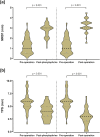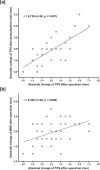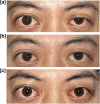Effect of Muller's muscle-conjunctival resection on the upper eyelid crease position in Asian eyelids: a retrospective cohort study
- PMID: 36131334
- PMCID: PMC9490903
- DOI: 10.1186/s12886-022-02605-6
Effect of Muller's muscle-conjunctival resection on the upper eyelid crease position in Asian eyelids: a retrospective cohort study
Abstract
Purpose: Investigating the effect of Muller's muscle-conjunctival resection (MMCR) on the eyelid crease position.
Methods: This retrospective study included patients with unilateral acquired blepharoptosis who underwent MMCR during October 2018-December 2021. The following factors were recorded: preoperative, after phenylephrine, postoperative marginal reflex distance1 (MRD1) and tarsal platform show (TPS) of bilateral eyelids. The primary outcome was to measure the change in TPS and evaluate the factors associated with post-operative TPS. The secondary outcomes included exploring the rate of MRD1 and TPS symmetry after the operation.
Results: Forty patients were included in the final analysis. The mean MRD1 of the ptotic eye was 1.28 ± 0.78 mm, 2.79 ± 0.66 mm and 3.20 ± 0.67 mm before, after phenylephrine and after the operation, respectively. The mean TPS of the ptotic eye was 5.90 ± 1.86 mm, 3.96 ± 1.49 mm and 2.79 ± 1.63 mm before, after phenylephrine and after the operation, respectively. Changes in mean TPS after the phenylephrine test and post-operation were statistically significant (p < 0.001). The linear regression model revealed that the absolute change in TPS after phenylephrine drop and absolute change in MRD1 post-operation were significantly correlated with the absolute change in TPS post-operation. Besides, the ratio of symmetry in MRD1 and TPS was greatly improved post-operation (82.5% and 70.0% respectively).
Conclusion: MMCR is an effective surgical method for ptosis correction as it can not only correct the eyelid crease position but also narrow the wide TPS. This method is particularly beneficial to patients with both mild to moderate ptosis and an asymmetric crease height.
Keywords: Blepharoptosis; Crease height; Marginal reflex distance; Müllerectomy; Tarsal platform show.
© 2022. The Author(s).
Conflict of interest statement
The authors have no competing interests to declare that are relevant to the content of this article.
Figures




References
MeSH terms
Substances
LinkOut - more resources
Full Text Sources

